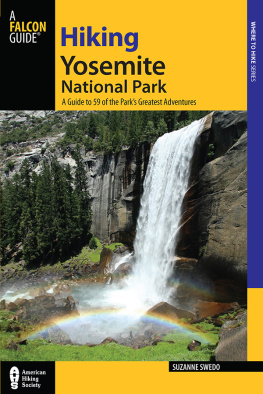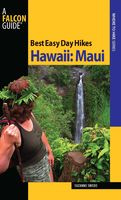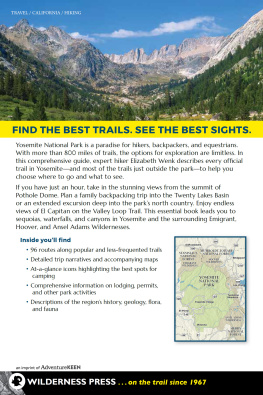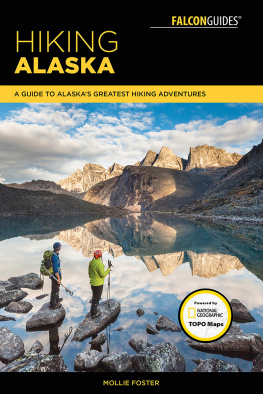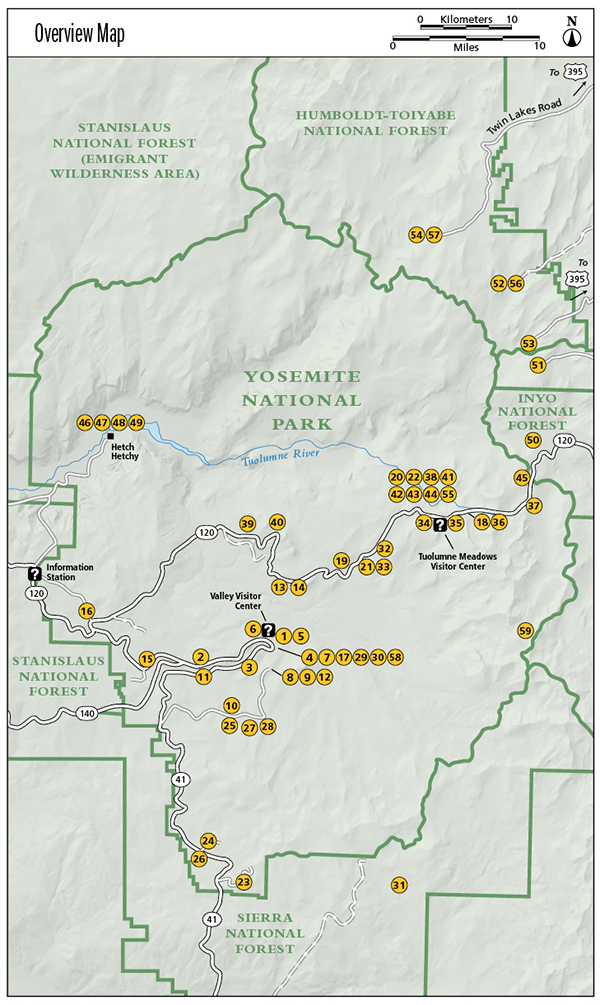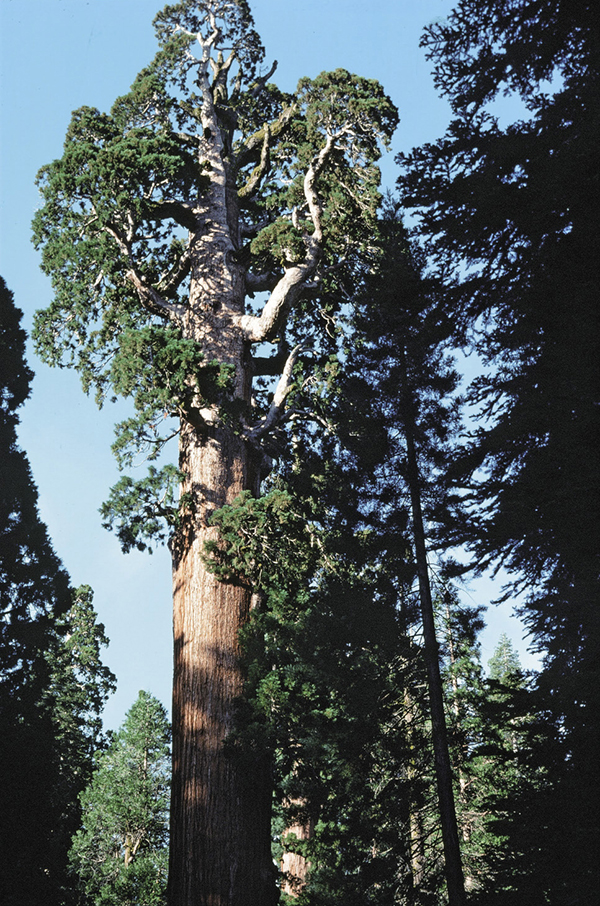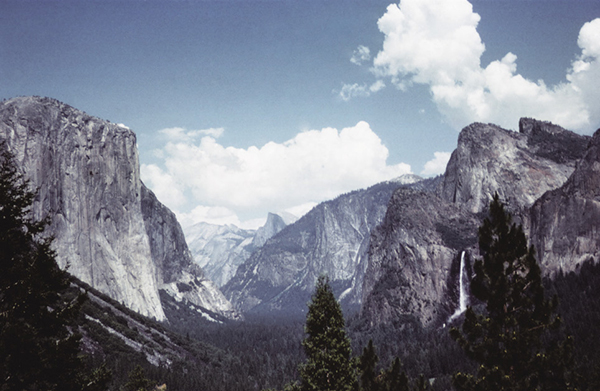Hiking Yosemite National Park
A Guide to 59 of the Parks Greatest Hiking Adventures
Third Edition
Suzanne Swedo
HELP US KEEP THIS GUIDE UP TO DATE
Every effort has been made by the author and editors to make this guide as accurate and useful as possible. However, many things can change after a guide is publishedtrails are rerouted, regulations change, techniques evolve, facilities come under new management, and so on.
We would appreciate hearing from you concerning your experiences with this guide and how you feel it could be improved and kept up to date. While we may not be able to respond to all comments and suggestions, well take them to heart, and well also make certain to share them with the author. Please send your comments and suggestions to the following address:
GPP
Reader Response/Editorial Department
P.O. Box 480
Guilford, CT 06437
Or you may e-mail us at: editorial@GlobePequot.com
Thanks for your input, and happy trails!
For my sister Jo
Copyright 2005, 2011 by Morris Book Publishing, LLC
A previous edition of this book was published in 2000 by Falcon Publishing, Inc.
ALL RIGHTS RESERVED. No part of this book may be reproduced or transmitted in any form by any means, electronic or mechanical, including photocopying and recording, or by any information storage and retrieval system, except as may be expressly permitted in writing from the publisher. Requests for permission should be addressed to Globe Pequot Press, Attn: Rights and Permissions Department, P. O. Box 480, Guilford, CT 06437.
FalconGuides is an imprint of Globe Pequot Press.
Falcon, FalconGuides, and Outfit Your Mind are registered trademarks of Morris Book Publishing, LLC.
Interior photos: Suzanne Swedo
Project editor: Julie Marsh
Layout artist: Kevin Mak
Maps by XNR Productions, Inc. Updated by Trailhead Graphics Inc. Morris Book Publishing, LLC
ISSN 1554-4303
ISBN 978-0-7627-9725-7
The author and Globe Pequot Press assume no liability for accidents happening to, or injuries sustained by, readers who engage in the activities described in this book.
Contents
Acknowledgments
Thanks to the many park rangers and other personnel and volunteers of the National Park Service in Yosemite who have been so generous with their time and assistance, especially Laurel Boyers and Dave Gansci, Linda and Alan Estes, and Deanna Petree. All have provided much valuable information and have helped to smooth the way.
The biggest debt of gratitude is owed to wilderness ranger Mark Fincher, who knows everything there is to know about the trails of Yosemite, and who, during his busy summer season, reviewed the manuscript and made comments and suggestions that were always right on target. What a joy to work with people whose lives have been dedicated to caring for and sharing their love of the most beautiful place in the world!
Also deeply appreciated are the support and assistance of June at the USDA Forest Service office in Oakhurst as well as Penny Otwell, Lou Carter, Pete Devine, Holly Kuehn, and all the hardworking staff at the Yosemite Conservancy, whose purpose it is to initiate and support interpretation, education, research, and scientific and environmental programs in Yosemite.
For their aid and encouragement, and plain good company in the field, thanks also to Joellyn Acree, Erica Crawford, Ed DeLeonardis, Minh Duong, Melinda Goodwater, Jane Magid, Sally McKinney, Fumiaki Nakamura, Jeff Nathan, Celia Ronis, Jane Sinclair, Sandy Steinman, and Karen and Ted Yellman.
The Grizzly Giant is one of the largest trees in the Mariposa Grove.
Introduction
Yosemite National Park occupies the heart of John Muirs Range of Light in the Sierra Nevada. The name means snowy range in Spanish, and in winter more than 60 feet of snow may accumulate. Yet the Sierra has also been called the gentle wilderness, because extremes of temperature are not great and the hiking days of summer are comparatively dry and sunny. It is a land of amazing diversity. Elevations in Yosemite range from 2,000 to over 13,000 feet, from the rolling oak woodlands of the western slope to the jagged mountain crest, where offspring of the great glaciers that carved the spectacular topography still lie in shady hollows above thousands of lakes. Then, to the east, the land abruptly drops away to the apparently endless sagebrush desert of the Great Basin. There are three groves of giant sequoia trees, the largest living things on earth, miles of forests and meadows, and a rich and varied collection of wildflowers, wildlife, and history galore. Then there is the incomparable valley itself, Yosemite, surrounded by massive granite domes and spires, booming waterfalls, and, in the summer season, teeming with tourists.
As many as 4 million people visit the park each year. Most concentrate their activities in Yosemite Valley, a mere 1-by-7-mile corner of the park. Those who are willing to explore on foot, however, can expect a genuine, uncrowded wilderness experience. Yosemites borders encompass almost 1,200 square miles, and almost 800 miles of excellent trails travel through some of the most dramatic and beautiful scenery on earth.
This book describes the best of them, how to find them, how to plan and equip yourself to tackle them, and what special, natural wonders to enjoy along the way.
How to Use This Guide
The purpose of this guide is to help you choose and plan a day hike or backpack in Yosemite best suited to your time, energy, experience, and personal preferences. It offers a preview of what you are likely to see and experience along your chosen route: geological features, historical sites, trees, birds, flowers, and mammals. It also helps you anticipate places where the trail is faint, where it is clear, and where and when rivers and streams are special sources of delight, or possible obstacles to travel.
Trail descriptions are intended to be used along with the US Geological Survey topographic maps available at wilderness outfitting and sporting goods stores, at visitor centers and shops in Yosemite, and through the USGS at P.O. Box 25286, Federal Center, Denver, CO 80225; (800) USA-MAPS; or www.mapping.usgs.gov.
Each trail description opens with a summary of the highlights and expectations for the hike. The statistical section provides a quick reference to the characteristics of the hike.
The classic view of Yosemite Valley looks to the east.
Within those characteristics, the Distance is described in miles. Youll also find out whether the route is a loop, in which you return to the place where you started without retracing your steps; an out-and-back hike, in which you return to the trailhead the same way you came; or a shuttle hike, in which you begin at one trailhead and end at another, requiring two vehicles, a shuttle bus, or another driver to pick you up or deposit you at either end.

